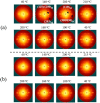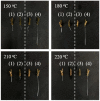Structure Mediation and Properties of Poly(l-lactide)/Poly(d-lactide) Blend Fibers
- PMID: 30961279
- PMCID: PMC6401892
- DOI: 10.3390/polym10121353
Structure Mediation and Properties of Poly(l-lactide)/Poly(d-lactide) Blend Fibers
Abstract
Poly(l-lactic acid) (PLLA) and poly(d-lactic acid) (PDLA) blend as-spun fibers (50/50, wt.%) were prepared by melt spinning. Structure mediation under temperature and stress and properties of poly(l-lactic acid)/poly(d-lactic acid)(PLLA/PDLA) as-spun fibers were investigated by wide-angle X-ray scattering (WAXS) and differential scanning calorimetry (DSC). The results show that highly oriented stereocomplex (SC) crystals can be formed in PLLA/PDLA blend fibers drawn at 60 °C and annealed at 200 °C. However, at drawn temperature of 80 °C, only lower oriented SC crystals can be formed. For PLLA/PDLA blend fibers drawn twice at 60 °C (PLLA/PDLA-60-2), the crystallinity of SC crystals increases with annealing temperature in the range of 200 to 215 °C, while the degree of orientation decreases slightly. When the annealing temperature is 210 °C, the crystallinity and orientation of SC crystals in PLLA/PDLA-60-2 fibers reach 51% and -0.39, respectively. Moreover, PLLA/PDLA-60-2-210 fibers exhibit excellent heat-resistant property even at 200 °C. The results indicate that the oriented PLLA/PDLA blend fibers with high SC crystals content can be regulated in a short time.
Keywords: PLLA/PDLA fibers; crystallization; heat resistance; orientation.
Conflict of interest statement
The authors declare no conflict of interest.
Figures








Similar articles
-
Crystallization and Alkaline Degradation Behaviors of Poly(l-Lactide)/4-Armed Poly(ε-Caprolactone)-Block-Poly(d-Lactide) Blends with Different Poly(d-Lactide) Block Lengths.Polymers (Basel). 2020 Sep 25;12(10):2195. doi: 10.3390/polym12102195. Polymers (Basel). 2020. PMID: 32992889 Free PMC article.
-
Relationship between the Stereocomplex Crystallization Behavior and Mechanical Properties of PLLA/PDLA Blends.Polymers (Basel). 2021 Jun 2;13(11):1851. doi: 10.3390/polym13111851. Polymers (Basel). 2021. PMID: 34199577 Free PMC article.
-
Crystallization behavior of asymmetric PLLA/PDLA blends.J Phys Chem B. 2011 Mar 31;115(12):2864-9. doi: 10.1021/jp111894m. Epub 2011 Mar 9. J Phys Chem B. 2011. PMID: 21384937
-
Stereocomplex formation between enantiomeric poly(lactic acid)s. 12. spherulite growth of low-molecular-weight poly(lactic acid)s from the melt.Biomacromolecules. 2004 Jul-Aug;5(4):1181-6. doi: 10.1021/bm049835i. Biomacromolecules. 2004. PMID: 15244428
-
Poly(lactic acid) stereocomplexes: A decade of progress.Adv Drug Deliv Rev. 2016 Dec 15;107:97-135. doi: 10.1016/j.addr.2016.04.017. Epub 2016 Apr 25. Adv Drug Deliv Rev. 2016. PMID: 27125192 Review.
Cited by
-
Homocrystallization and Stereocomplex Crystallization Behaviors of As-Spun and Hot-Drawn Poly(l-lactide)/Poly(d-lactide) Blended Fibers During Heating.Polymers (Basel). 2019 Sep 14;11(9):1502. doi: 10.3390/polym11091502. Polymers (Basel). 2019. PMID: 31540132 Free PMC article.
-
Biocompatible and Biodegradable Polymer Optical Fiber for Biomedical Application: A Review.Biosensors (Basel). 2021 Nov 23;11(12):472. doi: 10.3390/bios11120472. Biosensors (Basel). 2021. PMID: 34940229 Free PMC article. Review.
-
Three-dimensional crimped biodegradable poly(lactic acid) fibers prepared via melt spinning and controlled structural reorganization.RSC Adv. 2020 Nov 25;10(70):42890-42896. doi: 10.1039/d0ra08681a. eCollection 2020 Nov 23. RSC Adv. 2020. PMID: 35514938 Free PMC article.
-
Hydrophilic and Antibacterial Modification of Poly(lactic acid) Films by γ-ray Irradiation.ACS Omega. 2019 Dec 4;4(25):21439-21445. doi: 10.1021/acsomega.9b03132. eCollection 2019 Dec 17. ACS Omega. 2019. PMID: 31867539 Free PMC article.
-
A Novel Hydrophilic, Antibacterial Chitosan-Based Coating Prepared by Ultrasonic Atomization Assisted LbL Assembly Technique.J Funct Biomater. 2023 Jan 12;14(1):43. doi: 10.3390/jfb14010043. J Funct Biomater. 2023. PMID: 36662091 Free PMC article.
References
-
- Wang D.Y., Gohs U., Kang N.J., Leuteritz A., Boldt R., Wagenknecht U., Heinrich G. Method for simultaneously improving the thermal stability and mechanical properties of poly(lactic acid): Effect of high-energy electrons on the morphological, mechanical, and thermal properties of PLA/MMT nanocomposites. Langmuir. 2012;28:12601–12608. doi: 10.1021/la3025099. - DOI - PubMed
-
- Zhao X.M., Guerrero F.R., Llorca J., Wang D.Y. A new super-efficiently flame-retardant bioplastic-poly (lactic acid): Flammability, thermal decomposition behavior and tensile properties. ACS Sustain. Chem. Eng. 2016;4:201–209. doi: 10.1021/acssuschemeng.5b00980. - DOI
-
- Zhang X.Q., Jiang X.Z., Liu G.M., Liu Y.A., Wang R., Wang D.J. Effcet of orientation on crystallization behavior of poly(l-lactide acid)/poly(d-lactide acid) fibers. Acta Polym. Sin. 2014:1048–1055. doi: 10.11777/j.issn10003304. - DOI
-
- Rasal R.M., Janorkarc A.V., Hirt D.E. Poly(lactic acid) modifications. Prog. Polym. Sci. 2010;35:338–356. doi: 10.1016/j.progpolymsci.2009.12.003. - DOI
Grants and funding
LinkOut - more resources
Full Text Sources

